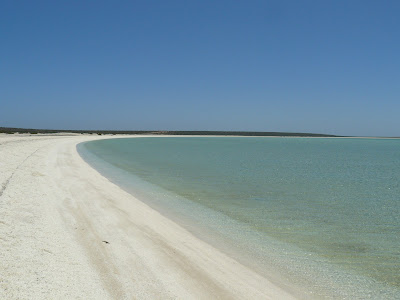 |
| People waiting on the pier, at about 7am, for the dolphins to arrive. |
We spent part of the morning waiting on the beach to see whether the dolphins would come in. They come in, if they feel like it, between 7.30 and 9am. This morning we waited until almost 9, before they turned up. Two days previously there had been 8, the day before none. Today 3 families of dolphins assembled plus some that are not part of specific groups, and we saw 18 in total. The dolphins all have different names and are identified by fin scars, and other body markings. Monkey Mia is in an area called Shark Bay and these sharks are they cause of most identifying scars. Some dolphins have had chunks bitten away, as dolphin is a main course in shark dinner. Every day the dolphins seen are logged and this is part of a long term ecological monitoring system. The staff know which calf belongs to which dolphin, and often the calves are lost to shark predation.
 |
| Dolphins waiting to be fed. Food given is only 20% of their daily intake and they are not dependent upon it. |
 |
| This is their usual dinner. A shoal of fish. |
The hotel at the Shark Bay site was a set out a bit like a holiday camp - lots of small chalets very close together, with little areas to sit out and planted beds between. There was a family of 5 emus that wandered around. An adult and 4 teenagers. The adult was the father, as the mother only lays the eggs then wanders off, leaving the responsibility of rearing the offspring to the father. Their favourite food is the round seedheads that grow on the palm trees. You could tell that they ate a lot of these, because their droppings were all around the site, and obviously, they do not fully digest the seeds! They were lovely birds and this was a small penalty in comparison to the delight of watching them.
We left Monkey Mia and had an early lobster lunch (locally sourced) which was wonderful. We ate at 11am, because restaurants are very few and far between, and this was the best time and place to eat.
We went along to a viewpoint called Eagle Bluff, where there is a walkway 50m or so above sea level. from here you could see clearly to the bottom of a shallow inlet, sheltered by a meadow of seagrass. In this water we saw about 6 stingrays, and at least 20 small sharks. It was an astonishing view.
 |
| Eagle Bluff |
This little island is visible from the viewpoint at Eagle Bluff, and is only inhabited by birds. Back in Victorian times it was heavily damaged by prospectors who identified the guano which is high in phosphates. Extensive collection was detrimental to the seabirds and the bay, but since the guano is no longer harvested, the environment is recovering.
We then drove to Shell Bay where the beach is comprised of tiny white shells, which are the only things that will live in this particular area, and can accommodate the extreme salinity of this piece of coastline. It was stunningly white and bright, and the water was incredibly clear.
We then drove to an area with Stromatalites. These are bacteria that live on the seashore, just underwater, give off oxygen and very, very slowly die off and form rock. You could actually see the bubbles forming and floating to the surface of the sea. We walked around a boardwalk and you could see the various different forms of bacteria because of slight differences in formation and clear differences in colour. Apparently these are very ancient bacteria that changed the course of evolution. When they formed, the oxygen level on planet earth was about 4% and these bacteria, over millions of years, raised the level to 20% and this enabled life forms that require oxygen to evolve. Amazing. And we actually saw these stromatalites giving off oxygen bubbles!
 |
| Stromalite rock emerging from seawater at low tide. |
 |
| More stromatalites |
 |
| Different shapes in the rocks mean a slightly different type of bacteria. |
We then had a few hours on the coach while it drove to Carnarvon, where we stay for 2 nights. We passed a recent roadkill sheep, and there was a wedge tailed eagle, acting as nature's dustman. The carcase was very recent, possibly today, and was starting to blow up already in the 40 degree heat. But the eagle looked very keen to tuck in, so I don't suppose the roadkill will be there for long.
Only about 400k today. Comparatively easy. Tomorrow we go on a glass bottomed boat and go snorkelling.
 |
| Shell Beach |



No comments:
Post a Comment